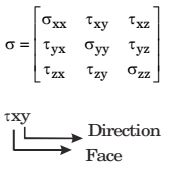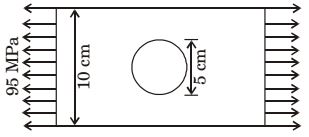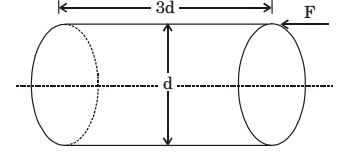Strength Of Materials Miscellaneous
- The three-dimensional state of stress at a point is given by

The shear stress on the x-face in y-direction at the same point is then equal to
-
View Hint View Answer Discuss in Forum

Correct Option: C

- A large uniform plate containing a rivet hole is subjected to uniform uniaxial tension of 95 MPa. The maximum stress in the plate is

-
View Hint View Answer Discuss in Forum

σ = P A
P = σ A = 95 × 106 × 10 × 10–2 tσ = P = 95 × 106 × 10 × 10–2 t = 190 MPa A (10 × 10-2 - 5 × 10–2)t Correct Option: B

σ = P A
P = σ A = 95 × 106 × 10 × 10–2 tσ = P = 95 × 106 × 10 × 10–2 t = 190 MPa A (10 × 10-2 - 5 × 10–2)t
- At a point in a stressed body the state of stress on two planes 45° apart is as shown below. Determine the two principal stresses in MPa.

-
View Hint View Answer Discuss in Forum

σx = 8 MPa
τxy = 3MPa
σn = 2 MPa
θ = 45°σn = σx + σy + σx - σy cos2θ - τxysin2θ 2 2 2 = 8 + σy + 8 - σy (0) - 3sin(90) 2 2
( σy = 2 MPa )σ1 , 2 = σx + σy + √ 

σx - σy 
² + τ²xy 
g 2 = 8 + 2 ± √ 

8 - 2 
² + 32 
2 2
= 5 ± 4.242
σ1 / 2 = 9.242, 0.758 MPa
Correct Option: D

σx = 8 MPa
τxy = 3MPa
σn = 2 MPa
θ = 45°σn = σx + σy + σx - σy cos2θ - τxysin2θ 2 2 2 = 8 + σy + 8 - σy (0) - 3sin(90) 2 2
( σy = 2 MPa )σ1 , 2 = σx + σy + √ 

σx - σy 
² + τ²xy 
g 2 = 8 + 2 ± √ 

8 - 2 
² + 32 
2 2
= 5 ± 4.242
σ1 / 2 = 9.242, 0.758 MPa
- A thin cylinder of 100 mm internal diameter and 5 mm thickness is subjected to an internal pressure of 10 MPa and a torque of 2000 Nm. Calculate the magnitudes of the principal stresses.
-
View Hint View Answer Discuss in Forum
di = o.1 m, do = di + 2t
t = 0.005 m, do = 0.11 m
T = 2000 Nm
P = 10 MPaσc = pdi = 10 × 106 × 0.1 = 50 MPa 4t 4 × 0.005 σc = pdi = 10 × 106 × 0.1 = 100 MPa 2t 2 × 0.005 T = τ J r τ = Tr J = 200 × 0.11 2 π (0.114 - 0.14) 32 σ1 , 2 = σx + σy ± √ 

σx - σy 
² + τ²xy 
2 2 = 50 + 100 ± √ 

50 - 100 
² + 24.142 
2 2
= 75 ± 34.75
= 109.75 & 40.25 MPaCorrect Option: A
di = o.1 m, do = di + 2t
t = 0.005 m, do = 0.11 m
T = 2000 Nm
P = 10 MPaσc = pdi = 10 × 106 × 0.1 = 50 MPa 4t 4 × 0.005 σc = pdi = 10 × 106 × 0.1 = 100 MPa 2t 2 × 0.005 T = τ J r τ = Tr J = 200 × 0.11 2 π (0.114 - 0.14) 32 σ1 , 2 = σx + σy ± √ 

σx - σy 
² + τ²xy 
2 2 = 50 + 100 ± √ 

50 - 100 
² + 24.142 
2 2
= 75 ± 34.75
= 109.75 & 40.25 MPa
- A circular rod of diameter d and length 3d is subjected to a compressive force F acting at the top point as shown below. Calculate the stress at the bottom most support point A

-
View Hint View Answer Discuss in Forum

Stress due to Axial forceσa = F = F = 4F (compressive) A (π / 4)d2 πd2
Stress due to bending:σb = My = Fd × d = 16F (tensile) 2 2 I π d4 πd2 64
Combined stress:
σr = σa + σbσr = -4F + 16F = 12F πd2 πd2 πd2 σr = 12F πd2
Correct Option: A

Stress due to Axial forceσa = F = F = 4F (compressive) A (π / 4)d2 πd2
Stress due to bending:σb = My = Fd × d = 16F (tensile) 2 2 I π d4 πd2 64
Combined stress:
σr = σa + σbσr = -4F + 16F = 12F πd2 πd2 πd2 σr = 12F πd2

